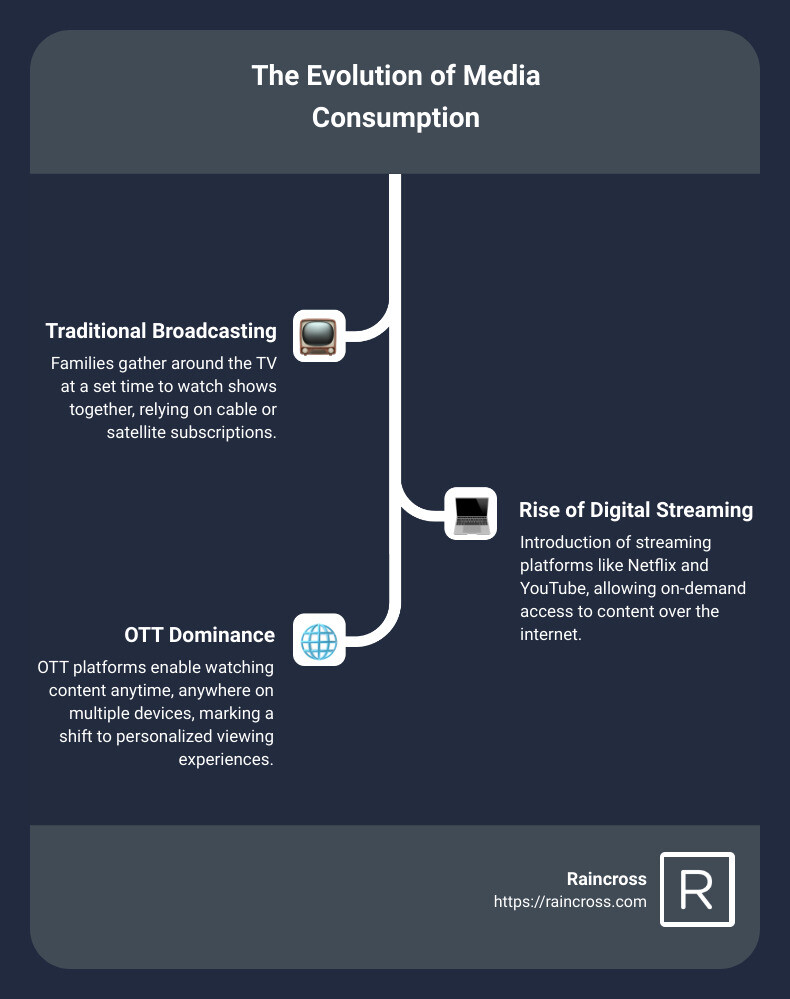Before diving into the rich world of OTT platforms, let’s clear the air with a simple definition to address the immediate question: What is OTT?
- OTT (Over-The-Top) technology refers to streaming services that deliver content directly over the internet. This means you can watch shows, movies, and other types of media on devices like smart TVs, mobile phones, tablets, and computers, without needing a traditional cable or satellite TV subscription.
The evolution of media consumption from traditional broadcasting to digital streaming marks a significant shift in how we access and enjoy content. Gone are the days when families would gather around the TV at a set time to catch their favorite show. Today, we live in an era where entertainment is on-demand, accessible at our fingertips, anytime, anywhere, thanks to OTT platforms.
OTT’s rise reflects a broader trend towards digital consumption, offering not just convenience but also a personalized viewing experience. As we navigate through this new digital landscape, understanding OTT becomes crucial for both consumers and businesses aiming to stay ahead in the rapidly changing media and entertainment industry.

Understanding OTT
When we talk about “what is OTT”, we’re diving into a world where your favorite shows, movies, and music are right at your fingertips, thanks to the internet. Let’s break it down into simpler parts: streaming technology, internet connectivity, and the devices you can use.
Streaming Technology
At its core, OTT uses streaming technology to send your favorite content directly to you over the internet. Unlike traditional TV, where you watch what’s being broadcasted at a specific time, OTT platforms let you choose what you watch and when. Think of it as the difference between a set menu and a buffet; with OTT, you’re always at the buffet.
Internet Connectivity
None of this would be possible without the internet. The better your connection, the better your streaming experience. Whether it’s fiber, Wi-Fi, or mobile data, a stable and fast internet connection ensures that your video doesn’t buffer right at the climax of the story.
Devices: Smart TVs, Mobile, Tablets, Gaming Consoles
One of the best things about OTT is that you’re not tied to a single device. You can watch on a Smart TV directly, or use devices like Roku or Apple TV to turn any TV into a smart one. Not near a TV? No problem. Your mobile phone or tablet works just as well. And if you’re a gamer, many gaming consoles now offer OTT apps too. Basically, if your device can connect to the internet, it can be your window to a world of streaming content.
To put it simply, OTT has transformed how we consume media, making it more accessible, flexible, and tailored to our individual tastes. Whether you’re into blockbuster movies, niche documentaries, or just want to binge-watch the latest series, OTT platforms have got you covered. And with the variety of devices available, you can enjoy your favorite content whether you’re at home, commuting, or anywhere in between.
In the next section, we’ll dive into the types of OTT services available, showing just how diverse this world is. From subscription services like Netflix to ad-supported platforms like YouTube, there’s an OTT service out there for everyone.

Types of OTT Services
In the vast universe of digital content, understanding what is OTT and the types of services it encompasses is crucial. So, let’s break down the main types of OTT services catering to diverse audience preferences and content consumption habits.
Subscription Video on Demand (SVOD)
Think of Netflix, Disney+, and HBO Max. These platforms are like all-you-can-eat buffets for movies and series. You pay a monthly fee and get unlimited access to a sea of content. These services have changed the game by offering entire seasons of shows all at once, perfect for the binge-watchers among us.
Advertising-Based Video on Demand (AVOD)
Platforms like YouTube, Pluto TV, and Freevee fall into this category. They’re free to use, but you’ll watch some ads along the way. It’s a trade-off many are willing to make, getting access to a wide range of content without opening their wallets.
Transactional Video on Demand (TVOD)
This model is more like a traditional rental store. Services such as the Amazon Prime Video Store let you pay for what you want to watch, like renting or buying a movie or a special event. Pay-per-view events, such as boxing matches or concerts, also fall under TVOD. You pay for a specific piece of content, often for a one-time viewing or limited access.
Free Ad-Supported Television (FAST)
Channels like Pluto and Samsung TV Plus offer a linear, TV-like experience but through the internet and for free. They’re supported by ads, and you can flip through channels just like old-school TV. It’s a nostalgic nod with a modern twist.
Premium Video on Demand (PVOD)
This is where services like Disney+ release their premium content. Remember when Mulan was released for an extra fee? That’s PVOD. You’re essentially paying a premium to watch new or exclusive content before it becomes available to wider audiences or subscribers without the extra fee.
Hybrid Models
Some services mix it up. Netflix introduced an ad-supported tier, making their service more accessible at a lower price point. Hulu+ with ads is another example, offering both subscription and ad-supported experiences. These hybrid models cater to viewers’ different preferences and price sensitivities.
Each type of OTT service offers its unique blend of content, accessibility, and user experience. Whether you’re looking to binge-watch your favorite series, catch up on the latest movies, enjoy live TV without a cable subscription, or explore premium content, there’s an OTT service that fits your needs. As the digital landscape continues to evolve, so too will these services, adapting to consumer demands and technological advancements.
Moving forward, let’s dive into the major OTT platforms that dominate the market and how they’ve reshaped entertainment consumption.
In exploring these platforms, we’ll uncover not only what they offer but also how they’ve become integral parts of our daily lives, changing the way we consume media forever.
Major OTT Platforms
When it comes to the digital age of entertainment and communication, a handful of names stand out among the rest. These are the OTT platforms that have not only changed the game but have also become household names globally. Let’s take a closer look at each of them.
Netflix
It all started with Netflix. What began as a DVD rental service transformed into the titan of streaming platforms. Netflix is the go-to for binge-watching TV shows, movies, documentaries, and original content. It’s known for its vast library and for producing critically acclaimed series and films. Netflix’s success lies in its subscription-based model, offering unlimited access to its content without ads.
Amazon Prime Video
Amazon Prime Video is another heavyweight in the OTT space, providing a wide array of movies, TV shows, and Amazon Originals. It comes as a part of the Amazon Prime package, which also includes benefits like free shipping on Amazon orders, making it a popular choice for consumers. Prime Video stands out for its collection of Bollywood content and regional Indian films, in addition to international titles.
Disney+
Disney+ is the dream come true for fans of Disney, Pixar, Marvel, Star Wars, and National Geographic. Launched in November 2019, it quickly captured the market with its family-friendly content and beloved franchises. Disney+ is also home to exclusive series and movies, expanding the universes of its major brands.
Hulu
Hulu offers a mix of TV shows, movies, and original content. What sets Hulu apart is its next-day access to shows from major networks, making it a favorite for keeping up with current TV series. Hulu also offers a live TV service, providing a cable-like experience with the convenience of streaming.
YouTube
YouTube needs no introduction. It’s the ultimate free platform for user-generated content, music videos, vlogs, tutorials, and more. While primarily known for its ad-supported model, YouTube also offers a premium subscription that removes ads and provides access to original content. YouTube’s global reach and vast content variety make it a staple in digital life.
Spotify
Shifting gears to music, Spotify leads the OTT audio streaming industry. It offers millions of songs and podcasts at your fingertips. With both a free, ad-supported tier and a premium subscription, Spotify caters to a wide audience, providing personalized playlists and discovering features that keep users hooked.
WhatsApp and Telegram
In the realm of communication, WhatsApp and Telegram have become essential OTT platforms. WhatsApp offers simple, secure messaging and calling for free worldwide, while Telegram is praised for its robust security features and flexible messaging options. Both apps have become crucial tools for personal and professional communication in the digital age.
Each of these platforms has carved out its niche in the OTT landscape, offering unique content and services that cater to diverse audiences. From binge-watching your favorite series on Netflix to catching up with friends on WhatsApp, OTT platforms have revolutionized the way we consume media and communicate, making it all accessible with just a click.
In exploring these platforms, we’ve uncovered not only what they offer but also how they’ve become integral parts of our daily lives, changing the way we consume media forever. As we look ahead, it’s clear that OTT platforms will continue to evolve, bringing new innovations and experiences to audiences around the globe.
Continuing from here, we’ll dive into the monetization strategies these platforms employ to generate revenue while offering value to users.
OTT Monetization Methods
OTT platforms have transformed how content is consumed and paid for. Let’s break down the main ways these platforms make money. This will give you a clearer picture of the landscape, whether you’re a content creator, advertiser, or viewer.
Subscription (SVOD)
Subscription Video on Demand, or SVOD, is like paying for an all-you-can-eat buffet. Once you’re in, you can watch anything on the menu. Netflix, Disney+, and HBO Max are prime examples. You pay a monthly fee and get unlimited access to their content library.
Ad-supported (AVOD)
Advertising-Based Video on Demand, or AVOD, is the digital equivalent of traditional TV commercials. Platforms like YouTube and Pluto TV let you watch content for free, but you’ll see ads. It’s a trade-off many are willing to make.
Transactional (TVOD)
Transactional Video on Demand, or TVOD, works on a pay-per-view basis. Want to watch a movie or a special event? You pay for what you want to watch. The Amazon Prime Video Store is a go-to for this model.
Free Ad-Supported Television (FAST)
FAST services, like Pluto and Samsung TV Plus, offer linear, TV-like channels for free, funded by ads. It’s a modern twist on the classic TV experience, without the monthly bill.
Premium Video on Demand (PVOD)
PVOD asks a higher price for early or exclusive access to content. Remember when Disney+ offered “Mulan” for a premium fee? That’s PVOD in action.
Hybrid Models
Some platforms blend these methods. Netflix introduced an ad-supported tier, while Hulu offers both ad-supported and ad-free subscriptions. This flexibility caters to different viewer preferences and budgets.
CPM Rates
Lastly, CPM (cost per thousand impressions) rates play a critical role in OTT advertising. It’s how much advertisers pay to show their ads 1,000 times. Higher CPM rates mean more revenue for platforms but require delivering valuable, engaged audiences to advertisers.
In essence, OTT monetization strategies are diverse, offering various ways for platforms to generate revenue while providing content to viewers in a format that suits their preferences. As the OTT space continues to grow, we’ll likely see even more innovation in how content is monetized.
Continuing from here, we’ll explore the advantages of OTT advertising, highlighting why it’s become a key strategy for marketers aiming to reach targeted, engaged audiences.
Advantages of OTT Advertising
Precision Targeting
One of the standout features of OTT advertising is its ability to zero in on specific audiences with laser precision. Unlike traditional TV ads that broadcast to a general audience, OTT platforms utilize viewer data to serve ads relevant to each individual’s interests, location, and viewing habits. This means your ad could be shown to a sports enthusiast during a sports documentary or to a cooking fan while they’re watching a cooking show. This level of targeting ensures that your advertising dollars are spent reaching the people most likely to be interested in your product or service.
Engaged Audience
OTT viewers are typically more engaged than traditional TV viewers. This is partly because they’ve chosen to watch a specific show or movie, rather than passively flipping through channels. Also, many OTT platforms require viewers to actively select content, which means they’re more invested in what they’re watching. This engagement translates to higher ad completion rates, with viewers often watching OTT ads to completion, especially since they’re not easily skipped like online video ads.
Better Analytics
OTT platforms offer comprehensive analytics, providing advertisers with insights into how their ads are performing. You’re not just told that your ad was served; you’re given detailed feedback on viewer engagement, ad completion rates, and even if the ad led to a direct action, like visiting a website. This data is gold dust for marketers, allowing for the refinement of campaigns in real time to ensure the best possible ROI.
Non-reliance on IDFA
With increasing concerns around data privacy and changes to IDFA (Identifier for Advertisers) rules, OTT advertising offers a viable alternative. Because OTT platforms collect their data, they’re not as reliant on third-party data, which is becoming more restricted. This means advertisers can still reach their desired audiences in a privacy-compliant way, without worrying about the tightening regulations around user data.
In summary, OTT advertising provides a powerful, precise, and privacy-compliant way for businesses to reach their target audiences. With its combination of precision targeting, engaged viewers, actionable analytics, and a non-reliance on IDFA, OTT advertising is not just the future of marketing—it’s the present. As the digital landscape continues to evolve, leveraging the advantages of OTT advertising will be key for businesses looking to stay ahead.
To further understand “what is ott” and its impact, consider exploring more about the major OTT platforms and how they’re shaping the future of content consumption .
Future Trends in OTT
As we peek into the future of Over-The-Top (OTT) services, it’s clear that this industry is not just thriving; it’s booming. With an ever-growing global audience, the potential for OTT platforms is massive. Let’s dive into what the future holds for OTT, focusing on growth projections, ad spending, model experimentation, the impact of 5G, and global expansion.
Growth Projections
The OTT market is on a steep upward trajectory. By 2025, it’s predicted that 3.3 billion people will be engaging with OTT video services. This isn’t just about more people watching; it’s about how they’re watching. With the proliferation of smart devices and improved internet access worldwide, OTT platforms are set to become the primary source of entertainment and information for billions.
Ad Spend Increase
As OTT platforms grow, so does the opportunity for advertisers. The next few years will see a significant uptick in OTT ad spending. In the US alone, spending on OTT video ads is expected to nearly double from $34 billion in 2020 to $63 billion by 2025. This surge reflects advertisers’ acknowledgment of OTT platforms’ ability to target and engage audiences more effectively than traditional TV.
Experimentation with Models
OTT platforms are continuously evolving, experimenting with various monetization models to see what best resonates with their audience. From subscription-based (SVOD) and ad-supported (AVOD) to transactional (TVOD) and hybrid models, the experimentation is bound to intensify. Netflix’s recent foray into ad-supported tiers is just the beginning, signaling a trend that others are likely to follow.
5G Impact
The global rollout of 5G technology is a game-changer for OTT services. With faster download and streaming speeds, 5G will enhance the viewing experience, allowing for higher-resolution content without buffering. This technological leap will not only improve existing services but also pave the way for innovative content formats that were previously not feasible.
Global Expansion
OTT is not just a Western phenomenon; it’s a global one. The Asia-Pacific region, in particular, is expected to see explosive growth, with user numbers projected to reach 1.345 billion by 2026. This expansion is partly due to localized content offerings that cater to diverse audiences, breaking the language and cultural barriers that traditional media could not.
In conclusion, the future of OTT is bright and brimming with opportunities. As technology advances and global internet access improves, OTT platforms are set to redefine entertainment, news, and education consumption worldwide. For businesses and advertisers, this means an ever-expanding arena to connect with audiences in more meaningful and targeted ways. The shift towards OTT is not just a trend; it’s the future of digital content consumption.
Frequently Asked Questions about OTT
As we delve into Over-The-Top (OTT) platforms, many of you have questions about what is OTT, how it’s different from traditional streaming, and how these platforms make money. Let’s address some of the most common queries.
What is the difference between OTT and live streaming?
The key difference lies in how the content is delivered and consumed. OTT refers to content accessed via internet services, bypassing traditional broadcasters, cable, or satellite platforms. This content is typically on-demand, allowing viewers to watch their favorite shows or movies anytime. Think of Netflix or Disney+; you choose what and when to watch.
Live streaming, on the other hand, is the real-time broadcast of events over the internet. It’s like live TV but delivered through the internet. Sports events, live concerts, or gaming tournaments are common examples. Here, you tune in as it happens, similar to traditional live TV but without the need for a cable subscription.
How do OTT platforms monetize their content?
OTT platforms have several monetization strategies, allowing them to cater to diverse audience preferences and maximize revenue. Here are the primary methods:
- Subscription Video on Demand (SVOD): Users pay a monthly or yearly fee to access a library of content. Example: Netflix.
- Advertising-Based Video on Demand (AVOD): Content is free for viewers, but ads are shown before or during videos. Example: YouTube.
- Transactional Video on Demand (TVOD): Users pay for each piece of content they want to watch. Example: Renting a movie on Amazon Prime Video.
- Premium Video on Demand (PVOD): Early access to special content for an additional fee over a subscription or free account. Example: Early access to a new movie release on Disney+.
- Hybrid Models: Combining several of the above methods to offer different tiers of access and pricing. Example: Hulu offers both ad-supported and ad-free subscriptions.
These models allow OTT platforms to cater to a wide range of viewer preferences, from those willing to pay for an ad-free experience to those who prefer free access supported by ads.
What are the major OTT platforms?
The landscape of OTT platforms is vast and varied, covering everything from video and music streaming to communication services. Here are some of the major players:
- Video Streaming: Netflix, Amazon Prime Video, Disney+, Hulu, and HBO Max dominate this space, offering a wide range of movies, TV shows, and original content.
- Music Streaming: Spotify leads the way, with other significant platforms including Apple Music and Amazon Music.
- Communication: WhatsApp, Telegram, and Signal offer messaging services over the internet, bypassing traditional SMS and phone calls.
Each of these platforms has carved out a niche, providing content and services that cater to the specific needs and preferences of their audience.
As the OTT space continues to evolve, we can expect to see new platforms emerge, existing ones expand their offerings, and the monetization strategies to become even more sophisticated. The future of content consumption is here, and it’s tailored to the viewer like never before.
Conclusion
The digital landscape is constantly evolving, and at the heart of this evolution is the shift towards Over-The-Top (OTT) platforms. These platforms have not only changed how we consume content but also how businesses connect with their audiences. The impact of OTT on the digital landscape cannot be overstated; it represents a monumental shift from traditional broadcast and cable models to a more personalized, on-demand consumption of media.
At Raincross, we understand the significance of this shift and have developed strategies to help businesses leverage the power of OTT platforms for growth. Our approach focuses on harnessing the precise targeting, engaged audience, and enhanced analytics capabilities of OTT advertising. This allows us to create more impactful and relevant interactions between businesses and their customers.
Why is OTT important for business growth? Because it offers a direct line to a highly engaged audience. With OTT platforms, advertisers can reach viewers who are increasingly opting out of traditional TV and seeking content that aligns with their interests and viewing habits. This presents a golden opportunity for brands to make meaningful connections with potential customers.
Furthermore, the analytics provided by OTT platforms give businesses unprecedented insights into viewer preferences and behaviors. This data is invaluable for refining marketing strategies and ensuring that advertising dollars are spent effectively.
As the OTT space continues to grow and evolve, Raincross is committed to staying at the forefront of this industry. We’re not just following the trends; we’re working to understand them deeply, so we can offer our clients the most effective solutions for their unique needs. Our goal is to help businesses navigate the complex OTT landscape with ease and achieve measurable success.
In conclusion, the rise of OTT platforms represents a significant opportunity for business growth. At Raincross, we’re excited to help our clients explore this potential and harness the power of OTT advertising to reach new heights. Learn more about our approach and how we can help your business thrive in the digital age by visiting our OTT / Connected TV Marketing service page.
The future of content consumption and advertising is here, and with the right strategy, businesses can achieve remarkable growth through OTT platforms. Let’s embark on this journey together.






About The Author: Kevin Watts
Kevin Watts is the founder of Raincross, a premier web design, development and digital marketing agency headquartered in Riverside, CA.
Kevin got his start in online marketing and website design by working for some of the most prominent names in online retail. He's most recognized for helping to start e-commerce retailer Organize.com in 1998, and spent 12 years running the company's e-commerce and online marketing operations. He has been recognized and has received several online retail, marketing and merchandising awards throughout his career.
Kevin grew up in Riverside, CA and graduated from the University of Wyoming. In his spare time, Kevin is an avid fly-fisherman, college football fan, and enjoys spending time with his son Matthew, daughter Kate and wife Lindsey.
More posts by Kevin Watts